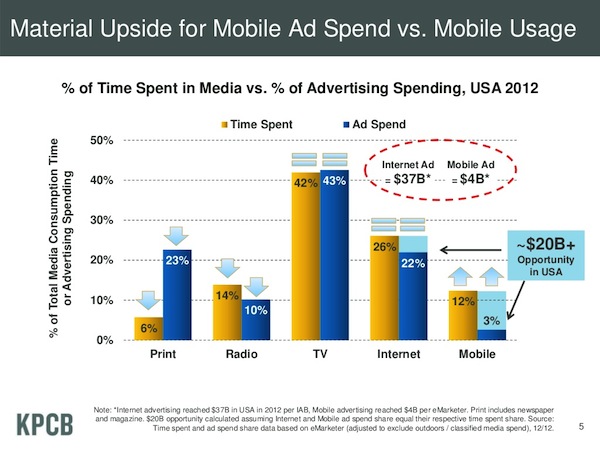I linked earlier to Mary Meeker’s new slide deck. For those who don’t know it, Meeker — formerly of Morgan Stanley, at VC firm Kleiner Perkins since late 2010 — each year produces a curated set of data reflecting what she sees as the major trends in Internet usage and growth. It may be the only slide deck that qualifies as an event unto itself.
Last year’s deck had one slide that I liked to cite when talking about the print advertising prospects for newspapers going forward. It’s this one:

The basic idea here is to compare the share of attention in various media to the share of ad spend. (This is U.S. data.) In other words: 43 percent of the time Americans spend consuming media is spent watching television. And 42 percent of the advertising dollars spent in America go towards television advertising. It’s a pretty good balance.
While there’s no ironclad law that ad dollars will always perfectly follow attention, it seems like a pretty good working assumption. And the main takeaways from that slide are (a) that print still gets a wildly disproportionate share of ad spend (25 percent) when compared with time spent (7 percent), and that (b) mobile is in the opposite situation — lots of attention (10 percent) but not many dollars (1 percent).
If you think that, all else equal, ad dollars will tend toward equilibrium with attention, that’s (a) a really scary thought for print — newspapers and magazines both — and (b) a sign that news organizations had better be putting a lot of effort into monetizing mobile.
That was last year’s slide. This is this year’s:

This picture isn’t any prettier. Print attention is down one percentage point; print advertising is down two. But the gap between them still yawns. Any time you hear someone be optimistic about the return of print advertising dollars, think about this slide and realize print ad dollars still have a long way to go down.
Meanwhile, mobile is continuing its move in the opposite direction: up 2 percentage points in time spent, and up the same in dollars. Mobile advertising went from a $1.6 billion business to a $4 billion business in a single year. Not much of that went to newspapers.
5 comments:
There’s a lot of golden information we’re missing here, so as it stands this data isn’t sufficient for action by advertisers. It’s a fair bet that print readers skew old, and that old readers skew wealthy. Additionally, the value of increased ad saturation in the mobile market is harshly limited by a simple fact of the platform: people have their phones out when they’re trying to do something specific. Following an ad’s link is a high cost action for users when they can’t just close a tab to return to the task for which they took out their phone in the first place.
Here’s a Nov. 2012 study suggesting the kinds of ads that mobile users do respond to are highly contextual, and generally don’t scale as readily ad groups would like. http://www.scribd.com/doc/116552773/tapjoy-mobile-study-9512
In other words, there may be a fire, but this ain’t the alarm.
Mary Meeker is hardly an unbiased observer. She’s very good at persuasive storytelling with charts, but not a person I’d hire to do anything requiring analytical competence or strategic decision making.
Actually, teenagers (12-18) are one of the segments of society with the highest amount of money available for consumer spending (at least in Germany, where I am from – but I bet its the same in the US).
I personally think that print (and TV) ads are compeltely overvalued. In any case, a 17 point gap between time and dollars spend points to the fact that something isn’t right.
But I agree with you that mobile ads are not necessarily the solution to that problem.
Yeah, it’s a really interesting question, and goes to show how little this information tells us in isolation. The ~$200bn spent by youth in the US is a huge chunk of discretionary non-durable good purchases, but pales in comparison to either new vehicle sales or medical care, which, anecdotally, are a lot of what I see advertised in print and on TV— less so on my phone, where I tend to see ads for clothes, electronics, and apps. I’d love to see the data ad firms have on this stuff, but not quiiiite enough to try and work at one.
Time spent really does not equate to media value, as anyone with any knowledge of people and media can tell you. See cogent arguments why not here: http://www.newsworks.org.uk/Opinion/time-spent-is-just-one-factor, http://bit.ly/ZKRWFq, and http://thinkboxblog.brandrepublic.com/2011/10/04/quality-time/
Trackbacks:
Leave a comment